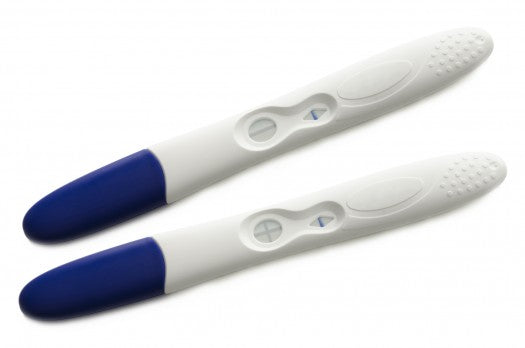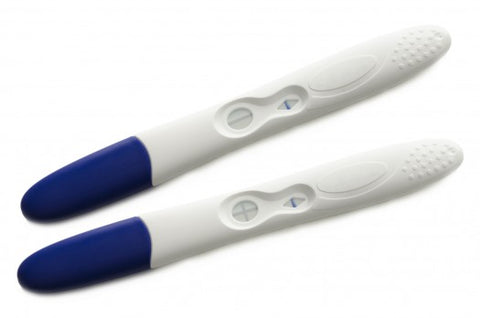
When Can I Take A Pregnancy Test and Get a Positive Result?

You are dying to know how long it will take for your pregnancy test will read positive. You’d love the answer today, but you are going to have to wait a while. Women who are trying to conceive call this awful waiting time the “two-week wait.”
Unfortunately, pregnancy tests are not magic. You cannot take one the morning after you had sex and assume that it will be positive or negative.
When Should I Take a Pregnancy Test?
We are going to start with the timing of when to take a pregnancy test. 95% of women will get an accurate result if they wait until their period has not arrived. If you want accurate results, wait.The other when question women ask is what time is the best time of day to take a pregnancy test. Most test instructions say that FMU (first-morning urine) is the best. Concentrated urine will have more reliable levels of the pregnancy hormone in it.
How a Pregnancy Test Works:
For a home pregnancy test to show a positive result, something special needs to happen. First, the fertilization of your egg needs to happen. After that, it has to implant itself in the uterus. After implantation, the placenta starts secreting the pregnancy hormone hCG into the body.A home pregnancy test tests your urine to see if there is any hCG (human chorionic gonadotropin) present. Once the level of hCG is high enough in your urine, the pregnancy test will show a positive result.
You use the pregnancy test by adding urine to it – either by urinating on it or by dipping the test into your urine. How you do it depends on the type of test you are using. You will pee on a midstream test and dip the pregnancy test strips.
The urine will move across the test. The results zone has a unique chemical in it that will react and create a line if it detects the pregnancy hormone. A colored line in the results area means hCG is present and you are pregnant.
How Soon Can a Pregnancy Test Show a Positive Result?
Urine pregnancy tests won’t show a positive result until about a week after implantation.Only 25 percent of women will read a positive pregnancy test 2 days before their period is due when using a sensitive pregnancy test.
Approximately 40 percent of pregnant women will get a positive test result the day before they have a missed period.
On average, it will take at least 13 days after ovulation for a urine test to first turn positive.
Variables to Consider Before A Positive Test Result Is Possible
Several factors may affect the time it takes for a pregnancy test to show a positive result. These include:- Date of ovulation
- Date of implantation
- hCG levels in your urine
- Pregnancy test sensitivity
Dates of Ovulation and Implantation
You need to know the date of ovulation to figure out when a positive result is possible. Fertilization occurs shortly after ovulation. It takes *about* 10 days for implantation to happen. For some women, it happens sooner, others later. One woman’s pregnancy test may show positive today, and another’s may only become positive a day or two later even if they conceived on the same day.hCG levels in your urine
For urine-based pregnancy tests, the hCG concentration will have to be about 20 Miu before a test registers a positive result. You usually have to wait until close to your period to take one. The concentration in your urine can vary through the day. You test first thing in the morning and get a positive result. When you take another, "I can't believe it!!" pregnancy test later, it could show a negative result. The concentration of hCG in your urine will change depending on your fluid intake during the day. This is why we recommended that you take your pregnancy test first thing after you get up. That is when your urine is most concentrated - unless you were up at night chugging water!Pregnancy Test Sensitivity
Pregnancy tests also vary in sensitivity. Pregnancy test sensitivities are indicated in mIU/ml, so a test with a sensitivity of 40 mIU/ml will need twice the amount of HCG than that of a test which has a sensitivity of just 20 mIU/ml. The 20 mIU test will show a positive result earlier than a 40 mIU test.
Research shows that the type of pregnancy test you use can affect your ability to interpret the test. Digital pregnancy tests are usually the easiest for the test takers. They state right on the pregnancy test that you are pregnant. There is no interpretation of the results required. The downside of these tests is that they cost considerably more than the less expensive formats like pregnancy test strips.
Conclusion: So When Does a Pregnancy Test Read Positive?
95 - 99% of women should receive a positive result, if pregnant, the day that their period is due. Testing before this time can result in a positive result. Though depending on the faintness of the result line, you may still not be sure if you are pregnant or not. Many tests on the market today will allow you to test 4 days before your period is due. You can start testing that early, but if you get a negative result, do not assume you are not pregnant. It could be that your body is just taking longer to produce HCG levels high enough to detect.
Sources:
Gnoth, C., & Johnson, S. (2014). Strips of Hope: Accuracy of Home Pregnancy Tests and New Developments. Geburtshilfe Und Frauenheilkunde, 74(7), 661–669. http://doi.org/10.1055/s-0034-1368589 M. (n.d.).
Home pregnancy tests: Can you trust the results? Retrieved March 08, 2017, from http://www.mayoclinic.org/healthy-lifestyle/getting-pregnant/in-depth/home-pregnancy-tests/art-20047940
Tags:
About Pregnancy Tests
Quick links
Search
Contact Us
Shipping Information
Helpful Info
Terms of Service
Privacy Policy
Do not sell my personal information
Contact us
About us
BabyHopes.com is a family owned and operated business, opened in January 2001. We have been serving the trying to conceive community for over 20 years.
